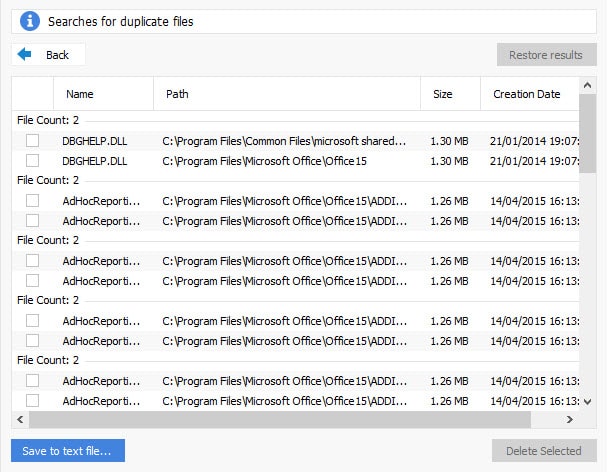
- CCLEANER DUPLICATE FINDER DOES NOT DELETE FILES FULL
- CCLEANER DUPLICATE FINDER DOES NOT DELETE FILES TV
- CCLEANER DUPLICATE FINDER DOES NOT DELETE FILES WINDOWS

Create a new shared drive structure with departmental folders that mimics what I think the X drive started out to be.We have a network shared known as "the X drive" that has been around forever and is a free-for-all dumping ground of files. I'm getting ready to do a similar thing here. If the blocks that make up a file are seen elsewhere (in other completely identical files, or even files containing some of the same data), a pointer to that block is used, but this all happens at a level below the filesystem. Now if I had set permissions, that may have saved me, but that's not always done by users.įile system deduplication happens at a block level, not a file level.
CCLEANER DUPLICATE FINDER DOES NOT DELETE FILES FULL
That symlink that replaced the full copy of the data allowed them to modify a file that's in my team drive. Next time I open "my" file, it's messed up. One of them opens what they think of as "their copy" and modifies it in a way that's only helpful to them. It's a complete duplicate, so gets replaced with a symlink. It's my file, I just sent it to them so they would have a copy of the data. So for example, I have a file in my team drive called "contacts" that I forwarded to a few people by email. If you use a symlink and delete one of the duplicates, what was two files becomes one. Multiple people purposefully working off their own copies of files is a different scenario. in which case symlinks are exactly what would work. This thread is about deduplication of files - which implies files of the same name/date/size.
CCLEANER DUPLICATE FINDER DOES NOT DELETE FILES WINDOWS
I'm familiar with deduplication, but I don't think it's offered on Windows Server 2008.looks like it was introduced in 2k8 R2. I will have to read up on this as I'm not familiar with symlinks. If you need to use symlinks in the filesystem, you actually need to use deduplication on the backend, which preserves the ability for users to modify "their" copy. This is *not* something you can do on a business file share- it's not the way they're supposed to work. So someone will have a file they copied to make changes on, maybe to use as a template- they'll open it, make changes, and now everyone else who had that file will have the new version, which they will see as corrupt. I was able to do this with CCleaner's duplicate finder, but DupeGuru has since found duplicates that CCleaner missed.Īgain, if two copies of the same file exist and you make one of them a link to the other, you lose the ability to change just one. I run DupeGuru on file server and it finds hundreds of duplicates.Īnother issue I'm having (with DupeGuru itself) is I can't just seem to "select all" of the second instance of the duplicate files to delete them in batch. The problem is there are far too many (at least potential) shortcuts to duplicates for me to know of. I don't see the issue if you remove the duplicate and on it's place leave a shortcut leading to the original.

Pointers under the file level (block level dedupe) allows two duplicate files in two locations to point to the same location on disk, but unlike a symlink, if someone edits one of them, the unedited one doesn't change. Sometimes there are legitimate reasons to have duplicate data. Symlinks don't help if you have two people who want to be able to edit their own copy of the duplicate. Things stay organized without needing 2 copies of a 4-8gb dvd.

CCLEANER DUPLICATE FINDER DOES NOT DELETE FILES TV
I have all our movies and tv shows in a main folder that my kids don't have access to, but i create symbolic links of their moves and shows to folders that my kids do have access to. If you do it after hours no one should even notice. Delete the duplicated and replace them with symbolic links. I would ignore the smaller files and just focus on anything large. Seems it should work with Server 2008 although i have not tested it. If some kind of auto-deduplication is not an option (i don't know of one for server 2008) then manually creating symbolic links is the next way to go. Shortcuts won't help when there are files that are hardlinked to others - like was mentioned earlier about access linking to excel files, or vice versa.


 0 kommentar(er)
0 kommentar(er)
